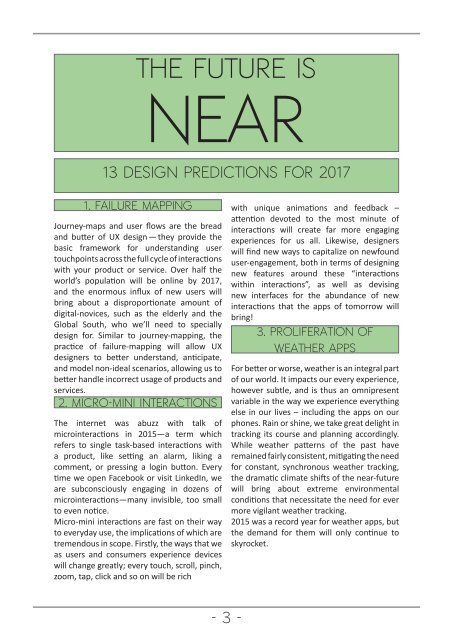Luke Priest Magazine
Create successful ePaper yourself
Turn your PDF publications into a flip-book with our unique Google optimized e-Paper software.
The future is<br />
Near<br />
13 design predictions for 2017<br />
1. Failure mapping<br />
Journey-maps and user flows are the bread<br />
and butter of UX design — they provide the<br />
basic framework for understanding user<br />
touchpoints across the full cycle of interactions<br />
with your product or service. Over half the<br />
world’s population will be online by 2017,<br />
and the enormous influx of new users will<br />
bring about a disproportionate amount of<br />
digital-novices, such as the elderly and the<br />
Global South, who we’ll need to specially<br />
design for. Similar to journey-mapping, the<br />
practice of failure-mapping will allow UX<br />
designers to better understand, anticipate,<br />
and model non-ideal scenarios, allowing us to<br />
better handle incorrect usage of products and<br />
services.<br />
2. micro-mini interactions<br />
The internet was abuzz with talk of<br />
microinteractions in 2015—a term which<br />
refers to single task-based interactions with<br />
a product, like setting an alarm, liking a<br />
comment, or pressing a login button. Every<br />
time we open Facebook or visit LinkedIn, we<br />
are subconsciously engaging in dozens of<br />
microinteractions—many invisible, too small<br />
to even notice.<br />
Micro-mini interactions are fast on their way<br />
to everyday use, the implications of which are<br />
tremendous in scope. Firstly, the ways that we<br />
as users and consumers experience devices<br />
will change greatly; every touch, scroll, pinch,<br />
zoom, tap, click and so on will be rich<br />
with unique animations and feedback –<br />
attention devoted to the most minute of<br />
interactions will create far more engaging<br />
experiences for us all. Likewise, designers<br />
will find new ways to capitalize on newfound<br />
user-engagement, both in terms of designing<br />
new features around these “interactions<br />
within interactions”, as well as devising<br />
new interfaces for the abundance of new<br />
interactions that the apps of tomorrow will<br />
bring!<br />
3. proliferation of<br />
weather apps<br />
For better or worse, weather is an integral part<br />
of our world. It impacts our every experience,<br />
however subtle, and is thus an omnipresent<br />
variable in the way we experience everything<br />
else in our lives – including the apps on our<br />
phones. Rain or shine, we take great delight in<br />
tracking its course and planning accordingly.<br />
While weather patterns of the past have<br />
remained fairly consistent, mitigating the need<br />
for constant, synchronous weather tracking,<br />
the dramatic climate shifts of the near-future<br />
will bring about extreme environmental<br />
conditions that necessitate the need for ever<br />
more vigilant weather tracking.<br />
2015 was a record year for weather apps, but<br />
the demand for them will only continue to<br />
skyrocket.<br />
- 3 -<br />
<strong>Magazine</strong>.indd 4 09/01/2017 10:33:28


